ASUS Maximus VII Impact Review: Premium Gaming Z97 in mini-ITX
by Ian Cutress on December 9, 2014 10:00 AM EST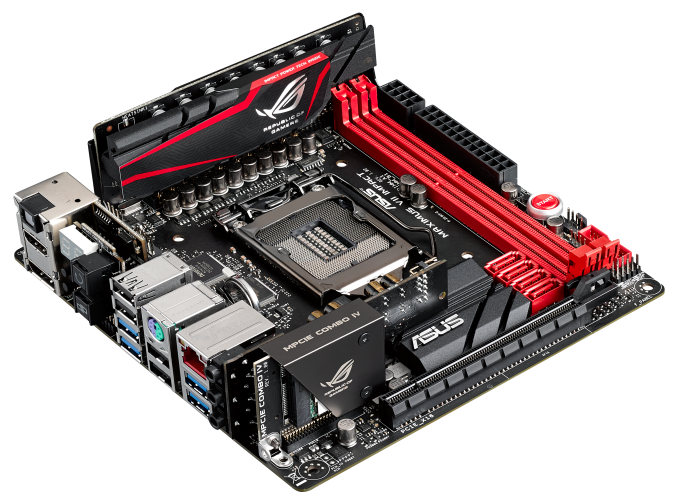
Over the years we have reviewed a number of Republic of Gamers (ROG) motherboards, usually focusing on the high end Extreme and gaming ATX focused Formula. We probed the Maximus VI Impact late last year and it offered a sense of premium to the high end that no other mini-ITX did, but we concluded it would be a tough act to follow. The sequel is now here with the Maximus VII Impact, ready for Haswell.
ASUS Maximus VII Impact Overview
When we think about small powerful computers, many manufacturers and end users can produce something impressive in something smaller than a shoe box. Custom designs are what they are, but for general production, we tend to stick to the predetermined sizes of mini-ITX, micro-ATX and ATX. The ROG brand is constantly marketed by ASUS as one of the best places for gamers to source components, but in ASUS’ effort to offer more functionality it would seem that the mini-ITX sized PCB isn't enough. This is why the Maximus VII Impact (M7I) has five additional circuit boards alongside the actual motherboard itself.
Some of these we were familiar with from the Z87 version of the Impact - a right angled power board, a connected audio board, Impact Control for rear IO buttons and the mPCIe combo with M.2 support and dual band 802.11ac WiFi. For the M7I all of these have evolved into a new iteration, including the mPCIe combo with M.2 x4, and a new daughterboard for extra fan controls. This is in response to requests from users who needed more than two or three fan headers that normally accompanies this size of product. This new board gives two extra headers that are both PWM and DC controllable on a small PCB near the rear panel.
Asus is also supplementing the design with their ROG software and BIOS package. From the BIOS perspective this means more overclocking options and presets with features like “GPU.DIMM Post” to indicate if slotted devices are detected at turn on. The software revolves around AI Suite III in a red and black livery with 5-Way Optimization as the key app. Alongside these are GameFirst III, ASUS' in-house version of network prioritization software, and KeyBot which allows the users to define the top keyboard function key row as preset macro buttons. These features can work in conjunction with the updated version of Sonic Radar II which enables an onscreen visual representation of directional sound in game. As an update over the previous version of Sonic Radar, we can configure what frequency band of audio is the focus for the visual (low bass, mid-range or high frequency). On the audio side we get SoundStage which offers a selectable hardware filter adjustment.
Benchmark wise, the impact comes out from our test suite rather well, scoring top marks in most of the tests due to the aggressive multicore turbo implementation going from idle to the maximum turbo frequency whenever CPU load is detected. POST times come in under 10 seconds, and load power consumption in our test-bed was under 150W for the system.
The Asus Maximus VII Impact is currently available for $240, making it the most expensive mini-ITX motherboard on the market, but it continues to lead the standard for premium small form factor gaming builds.
Visual Inspection
Out of habit, one of the first things I check on a mini-ITX motherboard is the power connector locations. Throughout the years the mainstay for mini-ITX power has been in the middle of the motherboard near the rear panel, meaning that cables have to stretch over components and causing potential air flow problems (and affectingthe look). Thankfully the Impact puts both the 24-pin and the 8-pin power connectors on the extreme right hand edge, where cable management should be pretty easy.
One of the downsides of a motherboard like the Impact is CPU cooler placements, as the socket is up against the Intel designated limits in at least two directions. In this instance it would seem that a closed loop liquid cooler might be best or custom water cooling for overclocking, although a stock cooler for base CPU speeds works as well. The motherboard has four fan headers – a 4-pin CPU at the top left, a 4-pin CHA on the right hand side and the final two on the CoolHub add-in card just to the left of the socket next to the rear IO.
This extra PCB gives two fully controllable headers as well as access to an LN2 mode switch for extreme overclockers.
One of the extra PCBs is the power delivery, now in its third iteration. For Z97 this one gets the new ROG look with ‘Impact Power Tech Inside’ written in the red accents. As shown in the picture above, the DRAM slots near this PCB do not have latches in order to fit everything on. This means users should be wary that their DRAM is firmly in place when installing.
On the right hand side of the motherboard beneath the power connectors are the power/reset buttons followed by a fan header and a USB 3.0 header in red to match the livery. The front panel header comes next, with enough space for ASUS to write on the board where each of the chassis connectors should go. At the bottom right of the motherboard just inside the DRAM slots are four SATA 6 Gbps ports, which unfortunately are all pointing in the same direction. This means that if a user has locking cables, the bottom cable can be an issue to remove.
There is a single PCIe 3.0 x16 slot at the bottom of the board, and as we come round to the left hand side we approach the mPCIe Combo IV card. This is upgraded for Z97, featuring an 802.11ac 2T2R WiFi solution as well as an M.2 x4 slot for storage. The previous model relied on x1 connectivity , whereas this is a fully fledged M.2 enabled device.
Next to the combo card is the audio PCB, featuring the next iteration of SupremeFX. This means an enhanced Realtek ALC1150 solution with an EMI shield, filter caps, PCB separation (it would be hard to get more separated than this) with the front panel audio connector provided on the card. Due to the design the card only has three audio connectors despite being rated as a 7.1 solution – at some point ASUS might release an Impact with a full set of audio connectors, although this has to be engineered.
The rear panel of the motherboard integrates the Impact Control II PCB, giving users a two-digit debug LED as well as BIOS Flashback, ROG Connect, SoundStage and KeyBot buttons. Added into the mix are two digital video outputs (HDMI and DisplayPort), four USB 3.0 ports, four USB 2.0 ports, a PS/2 combination port and the Intel network port. Further along to the right are the audio and mPCIe combo card outputs.
The SoundStage button switches between four op-amp profiles in the audio in order to adjust various elements of the audio via the hardware rather than software in real-time. This works in conjunction with Sonic Studio to help enhance audio clarity in voice or boost in the low frequency spectrum, depending on the use. ASUS call this latter implementation a ‘smart EQ’.
Board Features
| ASUS Maximus VII Impact | |
| Price | US (Newegg) |
| Size | Mini-ITX |
| CPU Interface | LGA1150 |
| Chipset | Intel Z97 |
| Memory Slots | Two DDR3 DIMM slots supporting up to 16 GB Up to Dual Channel, 1333-3300 MHz |
| Video Outputs | HDMI (4096x2160 at 24Hz, 2560x1600 at 60Hz) DisplayPort (4096x2160 at 24 Hz, 3840x2160 at 60 Hz) |
| Network Connectivity | Intel I218-V 802.11ac 2T2R Dual Band WiFi |
| Onboard Audio | Realtek ALC1150 via SupremeFX |
| Expansion Slots | 1 x PCIe 3.0 x16 1 x mPCIe 2.0 x1 (WiFi) |
| Onboard Storage | 4 x SATA 6 Gbps, RAID 0/1/5/10 1 x M.2 x4 |
| USB 3.0 | 4 x Rear Panel Ports (PCH) 1 x On-Board Header (PCH) |
| Onboard | 4 x SATA 6 Gbps Ports 1 x USB 3.0 Header 1 x USB 2.0 Header 4 x Fan Headers TPM Header Front Panel Header LN2 Mode Header Power/Reset Buttons ROG_EXT Header ProbeIt Measurement Points |
| Power Connectors | 1 x 24-pin ATX 1 x 8-pin CPU |
| Fan Headers | 1 x CPU (4-pin) 1 x CHA (4-pin) 2 x CHA (4-pin) via CoolHub PCB |
| IO Panel | HDMI DisplayPort Two Digit Debug USB BIOS Flashback Button ROG Connect Button SoundStage Button Keybot Button 4 x USB 3.0 4 x USB 2.0 PS/2 Combination Port Intel Network Port SupremeFX Audio |
| Warranty Period | 3 Years |
| Product Page | Link |


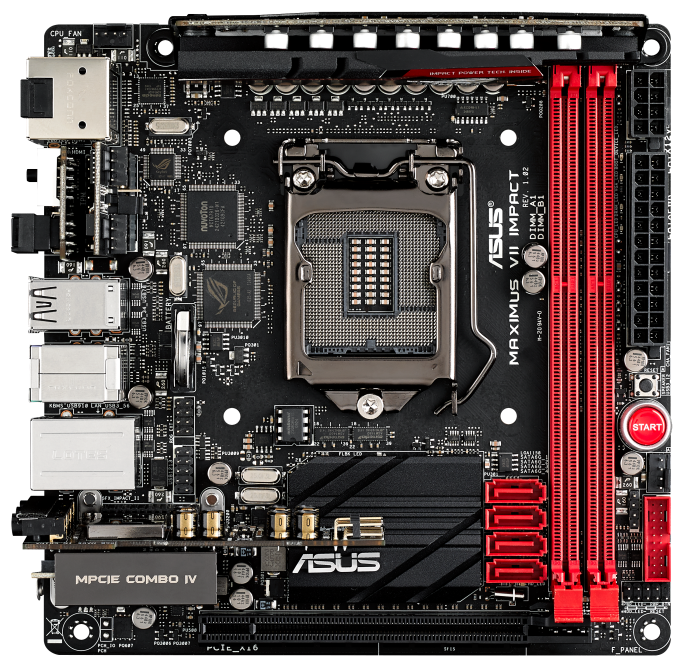

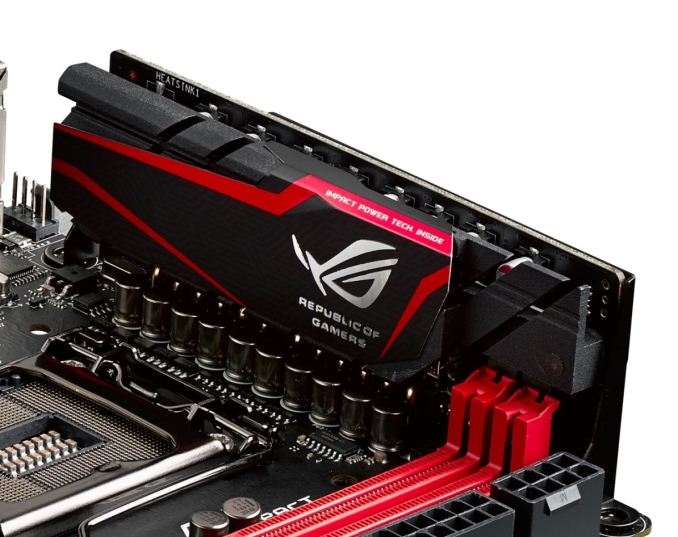
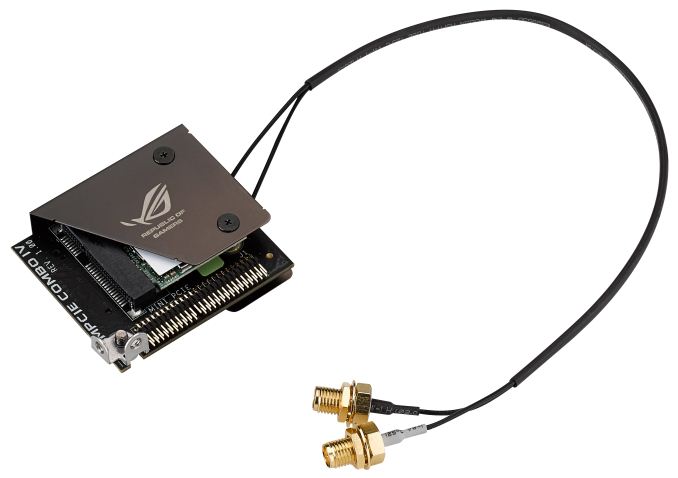
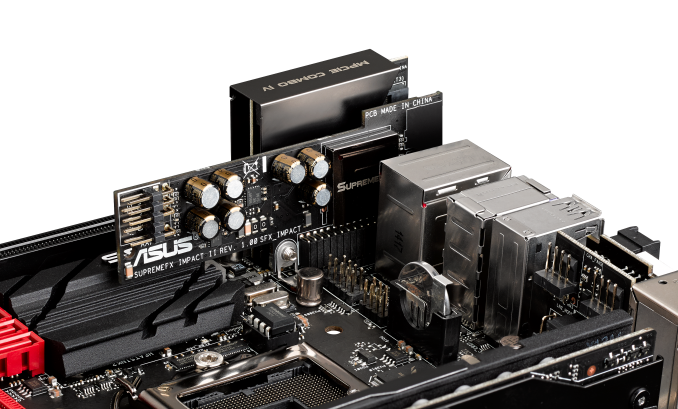















41 Comments
View All Comments
TheinsanegamerN - Tuesday, December 9, 2014 - link
looks like a very nice motherboard, if a tad expensive. especially the fan control with custom fan curves...wish my p8-z77 pro had that. wonder why 1.05 volt is the lowest voltage available?ME5H - Tuesday, December 9, 2014 - link
Man these boards are nice! Im pretty sure my next build will be a itx or atx, but for now my 2600k @ 4.8/GTX 780 can handle everything I throw at it. I was this close to buying a used Maximus for my 2600k but didnt trust them coming from Hong Kong :/ Thanks for the review. Peacevarg14 - Tuesday, December 9, 2014 - link
I am in the same boat with my CPU I have falling in love with going on 4 years old. A good ole Sandy Bridge i7 2600k @ 4.9ghz on a p67-ud4-b3 MB with 2 EVGA GTX 770 4GB Classifieds in SLI I do not see a CPU upgrade coming until PCI-E 2.0 @8X start limiting GPU performance at high res and settings. As of now you only see a real difference between 3.0 and 2.0 at low res with low settings.Morawka - Wednesday, December 10, 2014 - link
the real hero are the millions of i7 920's still in circulation. You can get one on ebay for like $75. Quad core with HT ftwmapesdhs - Thursday, December 11, 2014 - link
CPUs for P55 still run nicely too (cheaper than X58 CPUs, less power, easier to oc). I recently
tested an i5 760 @ 4.2GHz with single/dual 7970 3GB, it was easily able to match or beat a
5GHz 2700K with a single GTX 980. I can't post the URL here, but Google for, "SGI Ian pc
benchmarks". I tested with Stalker COP, CoJ, FC2, all the Unigine tests, and the 3DMark suites.
Only down side of Lynnfield CPUs is that P55 mbds have become highly valued for some
bizarre reason.
Best used value atm though is a Z68 board and a 2500K, as the mbds go for diddly.
Ian.
Samus - Thursday, December 11, 2014 - link
True the i7-920 (even the 950) are cheap, but a decent X58 board still sells for $200. I know because I just sold my Asus P6X Deluxe for that much on eBay. It's ridiculous how much these boards command, but I kind of get it, they're ridiculously good. I feel my H87's stability pales in comparison...but I wanted to do an ITX rig so the negligible performance increase and PCIe 3.0 weren't really the selling factors over X58.mooninite - Tuesday, December 9, 2014 - link
This review is a little late. The board has been for sale for a couple months now. There is one issue I've had with my board and it's with Turbo settings. The default core ratio settings are to sync all cores. This will bring your CPU outside of its rated spec and in the case of a i7 4790k it will cause your CPU to overheat and throttle at extreme loads. At first I thought I had a defective CPU, but after investigation the board is maxing out at 4.4ghz with 4 cores instead of 4.2ghz. With the correct settings my CPU does not throttle and stays within thermal limits. With an aftermarket cooler I can run at 4.4ghz on all cores, but just barely.This Turbo / stock CPU cooler issue should be a good topic for Anandtech to investigate. It seems many (all?) motherboards have wrong defaults for this and stock coolers cannot do the job.
varg14 - Tuesday, December 9, 2014 - link
Really overheats on stock voltage? What Cooler you using ? Also have you tried undervolting a tiny bit?Zap - Wednesday, December 10, 2014 - link
tl;drThis board (along with many other "enthusiast" boards) overclocks the CPU by default through "multicore enhancement." It has been around for a few years, and AnandTech even had an article about it.
http://www.anandtech.com/show/6214/multicore-enhan...
mooninite - Thursday, December 11, 2014 - link
No, I specifically said *default* settings. Not with XMP. Not with Multi-core-enhancement. ASUS, Gigabyte, and others are, by default, syncing ratios on all cores.